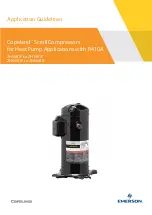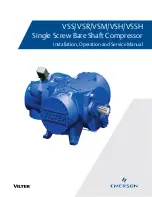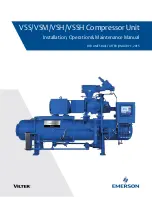
17
SB-500-2 i
Achtung!
Gefahr von Motor- und Verdich-
ter-Schaden!
Verdichter nicht im Vakuum star-
ten!
5.5 Kältemittel einfüllen
Nur zugelassene Kältemittel einfüllen
(siehe Kapitel 2).
• Bevor Kältemittel eingefüllt wird:
- Ölheizung einschalten.
- Ölstand im Ölabscheider kontrol-
lieren.
- Verdichter nicht einschalten!
• Flüssiges Kältemittel direkt in den
Verflüssiger bzw. Sammler füllen,
bei Systemen mit überflutetem
Verdampfer evtl. auch in den Ver-
dampfer.
• Nach Inbetriebnahme kann es not-
wendig werden, Kältemittel zu
ergänzen:
Bei laufendem Verdichter Kälte-
mittel auf der Saugseite einfüllen,
am besten am Verdampfer-Eintritt.
Gemische müssen dem Füllzylin-
der als blasenfreie Flüssigkeit ent-
nommen werden.
Bei Flüssigkeits-Einspeisung:
Achtung!
Gefahr von Nassbetrieb!
Äußerst fein dosieren!
Druckgas-Temperatur minde-
stens 30 K (R22, NH
3
) oder
mind. 20 K (R134a, R404A,
R507A) über Verflüssigungs-
temperatur halten.
Gefahr!
Berstgefahr von Komponenten
und Rohrleitungen durch hydrau-
lischen Überdruck.
Überfüllung des Systems mit
Kältemittel unbedingt vermeiden!
Achtung!
Kältemittelmangel bewirkt niedri-
gen Saugdruck und hohe Über-
hitzung (Einsatzgrenzen beach-
ten!)
!
!
!
!
!
!
Attention!
Danger of motor and compres-
sor damage!
Do not start compressor under
vacuum!
5.5 Charging refrigerant
Charge only permitted refrigerants
(see chapter 2).
• Before refrigerant is charged:
- Energize the oil heater.
- Check the oil separator oil level.
- Do not switch on the compressor!
• Charge liquid refrigerant directly
into the condenser resp. receiver.
For systems with flooded evapora-
tor refrigerant may also be charged
into the evaporator.
• After commissioning it may be nec-
essary to add refrigerant:
Charge the refrigerant from the
suction side while the compressor
is in operation. Charge preferably at
the evaporator inlet.
Blends must be taken from the
charging cylinder as "solid liquid".
If liquid is charged:
Attention!
Danger of wet operation!
Charge small amounts at a time!
Keep the discharge temperature
at least 30 K (R22, NH
3
) or
at least 20 K (R134a, R404A,
R507A) above condensing tem-
perature.
Danger!
Explosion risk of components
and pipelines by hydraulic over-
pressure.
Avoid absolutely overcharging of
the system with refrigerant!
Attention!
Low refrigerant charge causes
reduced suction pressure and
high superheating (observe
operating limits!).
!
!
!
!
!
!
Attenzione!
Pericolo di danni al motore ed al
compressore!
Non avviare il compressore se sotto
vuoto!
5.5 Carica refrigerante
Caricare solo dei refrigeranti consentiti
(vedi capitolo 2).
• Prima di caricare il refrigerante:
- Inserire la resistenza olio.
- Controllare il livello d'olio nel separa-
tore d'olio.
- Non inserire il compressore!
• Caricare il refrigerante liquido diretta-
mente nel condensatore o nel ricevito-
re; in caso di sistemi con evaporatore
allagato eventualmente anche nell'eva-
poratore.
• Dopo la messa in servizio può rendersi
necessario aggiungere del refrigeran-
te:
Con il compressore in moto caricare il
refrigerante sul lato di aspirazione, pre-
feribilmente all'ingresso dell'evaporato-
re. Le miscele devono essere scaricate
dal cilindro di carica come liquido privo
di bolle.
In caso di alimentazione di liquidi:
Attenzione!
Pericolo di funzionamento con ritor-
no del liquido!
Dosare molto precisamente!
Mantenere la temperatura del gas di
mandata almeno 30 K (R22, NH3) o
almeno 20 K (R134a, R404A,
R507A) al di sopra della temperatu-
ra di condensazione.
Pericolo!
Pericolo di rottura dei componenti e
delle tubazioni per sovrappressione
idraulica.
Evitare assolutamente la carica
eccessiva di refrigerante nel siste-
ma!
Attenzione!
La mancanza di refrigerante provo-
ca una bassa pressione di aspira-
zione e un surriscaldamento notevo-
le (osservare i limiti d'applicazione!).
!
!
!
!
!
!
Содержание OS.53 series
Страница 27: ...27 SB 500 2 i ...












































